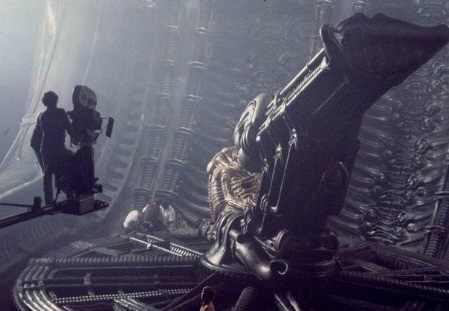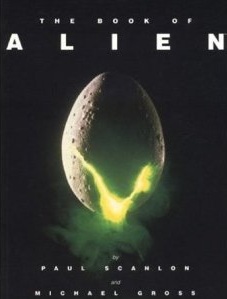"The most important thing in a film of this type is not what you see, but the effect of what you think you saw." - Ridley Scott
Ever wonder about what went on behind the scenes to make the seminal movie Alien? Scanlon and Gross set out to provide the information on the look and feel of the movie, while talking to cast and crew, and relating stories about the movie's genesis. While you won't get all the answers you may be craving you will get some insight into how the vision you see in Alien came about, even better you get information on scenes that were not included in the final movie, including the "Pyramid" that proved too expensive to include under the $11 million production budget. Let's go check out the set of Alien as the aesthetic evolved in the minds of the Designers and Directors.
Unfortunately for those expecting the full story of how Alien came about the text is pretty skimpy, and covers the origins of the movie in pretty scanty details. Thus we learn that O'Bannon's original name for the script was The Star Beast, how Giger came to be involved in the project, and how the movie may have been different with a bigger budget. For example the original script called for a pyramid structure that is discovered by our explorers with an opening at the top. One of the astronauts is lowered into the structure from the top with the egg chamber being in the pyramid and not in the crashed alien spaceship that has become to be known as the derelict. Interestingly the much maligned Director Paul W. S. Anderson would revisit the pyramid concept in the 2004 movie Alien vs. Predator.
Perhaps even more alarming for readers seeking arcane Alien knowledge is the text of The Book of Alien isn't going to take you that long to read, most of the book is comprised of set shots, concept drawings, and full page stills from the movie. The term "picture book" almost comes to mind but there is enough text on the bone to give you some insights into various aspects of the movie that you may not have known about previously.
The illustrations and photos included in the book are it's real strength, with the sum adding up to a visual treat for those wondering how the concept of the various creatures made their way to our screens. Thus we get the evolution of the adult Alien from Giger's Necronomicon IV art, through various incarnations, to finally the fully realised creature that terrorised the crew of the Nostromo. Giger creates a surreal beauty to the creature that extends beyond it's menacing black visage, the book captures this visual and shows how concepts became a reality that could be capture on film. It's surprising the amount of concepts and designs were churned out for Alien that never made it to the final screen version. French designer Moebius spent time on the movie without contributing much beyond the space suits, Chris Foss supplied a virtual avalanche of drawings that went unused, and Ron Cobb supplied all manner of alien visions that were never used. You could have a book about ten times the size of the one we have in our hands to do true justice to the amount of artwork that flowed during the design and production stages of Alien.

It was interesting to read the interpretations given to the "Space Jockey" by Scott and his crew. The Director speculated that the derelict was either a military vessel or a cargo ship journeying between two points on some undefined mission. The crew felt the space farer had a benign aspect to his design that would not be realised in the latest movie in the series, Prometheus. Equally the Dark Horse series of novels and comics painted a much more belligerent race than the one the first movie seeks to present. Clearly the creature was at one time meant to have a more developed non-human culture, but was retained in it's finally metamorphosis without being fleshed out, no pun intended there.
Working with Giger on the movie must have been a nightmare given the Swiss Surrealist's almost maniac believe in biomechanics. Apparently Giger ordered truck loads of bones in order to construct the interiors of the derelict spaceship. Given the movie was filmed in summer the smell from fresh bones must have been about as pleasant as arse, but spare a thought for John Hurt who had to endure a false chest cavity filled with fresh offal. There are harsh filming conditions and then there are almost masochistic filming conditions.
While noting the lack of text on the actual movie I was still rocking along to the illustrations and photos as the book delivered an insight into various aspects of the design of Alien. Giger sounds like just the right genius a movie like Alien needs in order to make it to the screen, and Ridley Scott is only enhanced as a Director for mine due to his ability to draw the best from divergent Designers and set makers. If you are a fan of Alien then this is a must read book, if a fan of movie making then I would also urge you to grab a copy of The Book of Alien. Art students will no doubt get something out of the experience as well. So yeah full recommendation folks, rock on and see how some distinct cinematic designs came about.
If after a copy of The Book of Alien then your best bet is to order via amazon.com, it's going to cost you around $15 but would be cheap at twice the price.




 Excellent look into the development of the Alien designs.
Excellent look into the development of the Alien designs.